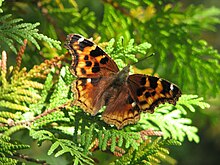Nymphalis l-album
| Compton Tortoiseshell | |
|---|---|
 |
|
| N. vaualbum, Temagami, Ontario | |
| Scientific classification | |
| Kingdom: | Animalia |
| Phylum: | Arthropoda |
| Class: | Insecta |
| Order: | Lepidoptera |
| Family: | Nymphalidae |
| Genus: | Nymphalis |
| Species: | N. vaualbum |
| Binomial name | |
|
Nymphalis vaualbum ([Denis & Schiffermüller], 1775) |
|
| Subspecies | |
|
N. vaualbum j-album (Boisduval & Le Conte, 1835)) |
|
| Synonyms | |
|
|
N. vaualbum j-album (Boisduval & Le Conte, 1835))
N. vaualbum l-album (Esper, 1781)
The Compton Tortoiseshell (Nymphalis vaualbum or N. l-album), also known as the False Comma, is a species in the Nymphalidae family.
An assertion that the name Nymphalis l-album is in fact the correct name over the widely used Nymphalis vaualbum proved to have backing when it was discovered the description covering vaualbum did not include a description or type specimen. Thus vaualbum can be considered nomen nudum, giving Nymphalis l-album priority.
The underside of both the male and females wings are dark mottled brown, much like tree bark. While the outside is "dull" and bark-like, the inside is orange-brown with dark tips. There is a single white dot or comma on the underside of each wing of both males and females similar to that of the Comma butterfly (Polygonia c-album), hence the name False Comma.
It is seen in deciduous and coniferous forest in a wide range throughout the Northern Hemisphere. The nominate subspecies (N. v. l-album) is found throughout central Asia. The subspecies, N. v. j-album's, range consists of Alaska and Canada south into Montana and Wyoming. They are seen east to New England and eastern Canada and south to North Carolina and Missouri. They rarely migrate to Newfoundland and Labrador, Nebraska, and Florida. You can also find this species in temperate Eurasia including Caucasus.
The adult female will lay her eggs in a clump on the host plant. Once the eggs hatch the caterpillars will feed together until they pupate. There is one brood that flies from July to November.
...
Wikipedia
